#Kny Fandom Theories and Meta
Text
Just thinking about how Chachamaru is a male calico, at least according the Taisho Secret right before chapter 195 that calls him manly. It really doesn't surprise me that he's male, because so many references to calicos I've seen in manga, mascots, and temple architecture specify that the featured calico is male.
This is because they are rare, and therefore considered lucky.
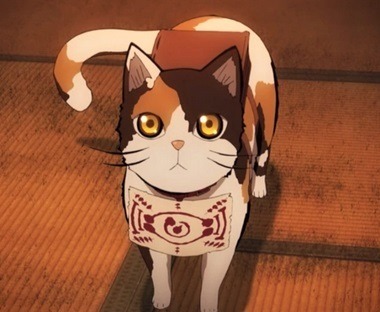
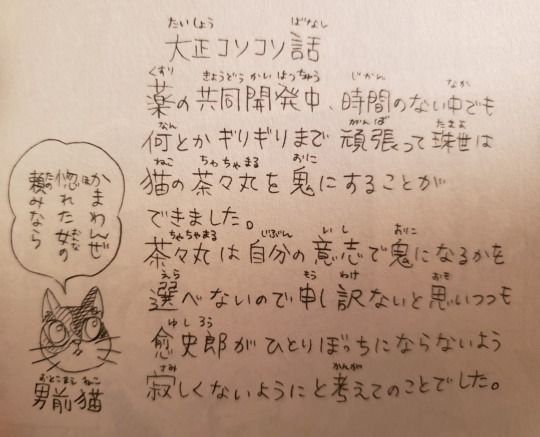
The figure that gets thrown around the internet is that supposedly only 1 in every 3000 calicos is male. (I'll bet the people who did the often quoted study at U. of Minn. College of Vet Med would love to tell you how it's more complicated than that.) This has long made male calicos popular not only in Japan, but in other countries as well. The thing is, though, the male calico might not always be so lucky.
To be very brief about why calicos (and some other multicolored cats) are almost always female, this is because, put very simply, one X chromosome gives us the black splotches, and one X chromosome gives us the orange splotches. That might leave you wondering where the white patches come from, and this is the part where I say that genetics is never simple and you should have fun reading about it. The important takeaway here is that in order to show this color pattern, a cat needs two X chromosomes, one from its mother and one from its father.
Typically, a male cat has an X chromosome (from its female mother, who only has two X chromosomes) and a Y chromosome (from its father, who had both an X and a Y), but because the calico coating can only occur with two X chromosomes, this male cat somehow got an X, a Y, and... hmm, another X somewhere.
So not a typical XY male, not a typical XX calico... this sterile XXY male calico has an extra chromosome, and mutations often are not ideal for the health of the animal with the extra chromosome. This particular condition is Klinefelter’s Syndrome, which can lead to a male calico having cognitive and behavior issues, weaker bones, increased risk of diabetes due to higher body fat, and perhaps a shorter lifespan.
Now, none of the fictitious lucky cats I've seen have ever been portrayed as anything less than smart and pleasant, though a lot of the maneki-neko are pretty round. For everything Chachamaru is tasked with, I have to assume he's above-average when it comes to intelligence, reasonably healthy enough to handle long-distance travel, and for a cat, he's extremely, extremely cooperative.
For the record, the same Taisho Secret (as well as Yushiro's statement in Chapter 194) makes it clear that for most of canon Chachamaru was a regular cat, for he was not made into a demon until right before the final showdown with Muzan. Even with her hands full making the medicine for Muzan, she still put a lot of effort into changing Chachamaru so that Yushiro wouldn't be lonely. It's ironic that Chachamaru winds up immortal, rather than doomed to a potentially shorter lifespan due to his mark...ings.
In the first place, was Tamayo perhaps moved with pity for a sickly kitten and nursed him to the health he's in now?
Or did she always keep her eye out for a male calico, wanting to put some faith in them being good luck?
Also, what sticks out to me in this Taisho Secret is that Chachamaru, not having a language in which he could communicate with Tamayo, had no choice in becoming a demon. Tamayo felt sorry about that. The word bubble over manly little Chachamaru says, with bravado, "Fine by me, if that's what the woman I'm smitten with wishes."
If Chachamaru truly is that smitten with her, that perhaps accounts for what an unusually cooperative cat he is. But it also reminds me of a fan theory that I saw once (and found worthy of weight) which said that perhaps Tamayo's blood technique has an effect like makes others smitten with her, and Yushiro might had been under its influence, however strongly or subtly. If such a thing were the case, it might or might not had been something Tamayo was conscious of. If she was conscious of having some effect like that, she probably felt awful about it but found it a necessary precaution to keep any demon she made under control. If she wasn't conscious of such a thing, that means she might had subconsciously developed it out of loneliness, and had been trying to keep company at her side.
208 notes
·
View notes
Text
Sibling: Why do Water Breath users smell so good?
Me: Probably because they take showers.
6 notes
·
View notes
Text
This is the Hashibira House--hear me out

I've mentioned this idea in a few posts here and there, but I'm putting it here with my nine reasons:
I think Tanjiro will ask Inosuke to inherit the family home and charcoal kiln.
Reason 1.
Kanata and Sumihiko live in the city and show no ties to charcoal farming.
This makes me very sad, but although they inherit Tanjiro's sword and the earrings, and although the two of them both perform Hinokami Kagura at a local shrine at New Years (Fanbook #2 Taisho Secret), they are is no mention of charcoal aside from the "sumi" in Sumihiko's name. Even then, he is the second son, so it's kind of like they forgot the family traditional when Kanata was born. Really goes to show how much they still value the old family trade that kept them working with fire, hmph!
Although Tanjiro knew the need for charcoal was decreasing (Fanbook #2 post-epilogue comic), and although he'd probably be happy to see his descendant free to be a parkouring zookeeper, that's still generations of the family trade that's been tossed out. Not that Hinokami Kagura is needed in their world anymore, but still, that sucks some of the meaning dry. So again, I am sad.
Reason 2.
There is precedent for the house and its legacy to be passed around.
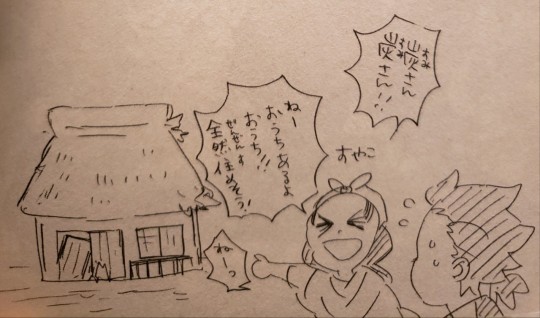
According to the Taisho Secret right before Chapter 191, the house was previously used by Yoriichi and "Uta." It only became the Kamado house once Suyako and Sumiyoshi came across it when it was abandoned.
It was temporarily abandoned again later on when Tanjiro had to take Nezuko and make a run for it, and despite all the care taken of it the house is already hundreds of years old, so it wouldn't be surprising if it gets abandoned again.
Still sad, though.
Reason 3.
Tanjiro already kind of expected he wouldn't live there long.
In the Fanbook #2 post-epilogue comic, Tanjiro mentions that even though he doesn't need to, he likes working, and he wants to leave money for everyone when he's gone.
He feels the effects of his injuries and everything else he's been through, and needs regular check-ups down at the Butterfly Mansion. Maybe he'll be fine for most of the years he has left, but what if it's a steady decline from the easily-tired point he's already found himself in? Take care of the house is going to take more and more out of him, and his children won't be old enough to take on many responsibilities before he's 25.
He's at peace with the understanding that he'll be gone someday and hopes the others will live peaceful lives without him.
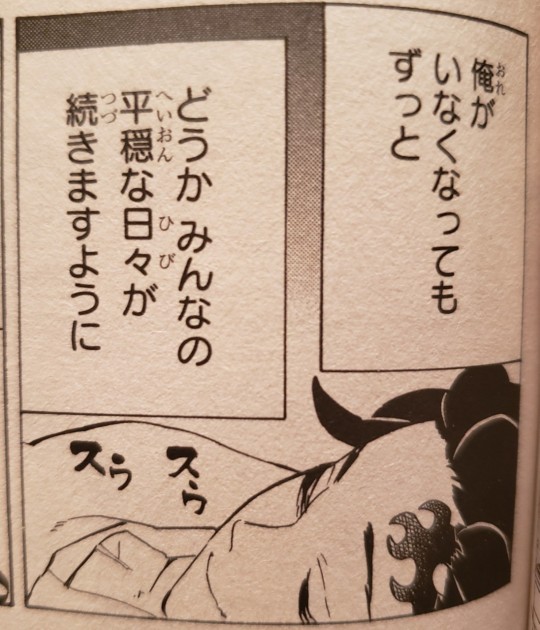
We know that Kamaboko living arrangement couldn't had lasted long, though, because he and Kanao go on to have descendants together.
Reason 4.
Kanao's not going to have Kaburamaru for long.
As much as I have faith in Kanao to live near-blind in the deep mountains, it's going to be a bit harder once she loses her seeing-eye snake, and Kaburamaru's already a somewhat old snake by the time she inherits him. If she's going to continue being a doctor, she may have an easier time of that staying in the Butterfly Mansion with all the resources there, and patients coming to her (a challenge to ask them to go up the mountain for her services).
Reason 5.
There's someone who might do just fine without those extra conveniences and resources, for she is very resourceful.
Even though Kanao would insist the contrary, Aoi--who always called Shinobu by "-sama" and never "-neesan"--might feel Kanao has more claim to inherit the Butterfly Mansion, for Aoi was always a little hard on herself and insecure in her role as a failed Corp member. I stress again, none of this would make a difference to Kanao, who knows Shinobu cared about Aoi just as much. As much as Aoi has demonstrated her ability to run a clinic, I have just as much faith in her to run a mountain household, including handling its inevitable repairs, as well as to go make house calls around the village whenever needed.
Reason 6.
Inosuke is more genki than anybody.
And, more importantly, he's learned to make charcoal.

This takes us back to the comic in Fanbook #2, where Inosuke is so well-adjusted to life in the Kamaboko household that he's not only learned the charcoal trade well enough to say, "buy Inosuke-sama's charcoal," but he's also a shining star when it comes to doing chores. He's doing really well with growing up and taking on human responsibility!
He is also, however, the King of the Forest. That's his home, and even when spending long periods of time in the Butterfly Mansion, the forests call him.
Reason 7.
You know who else loves nature?
This dude.
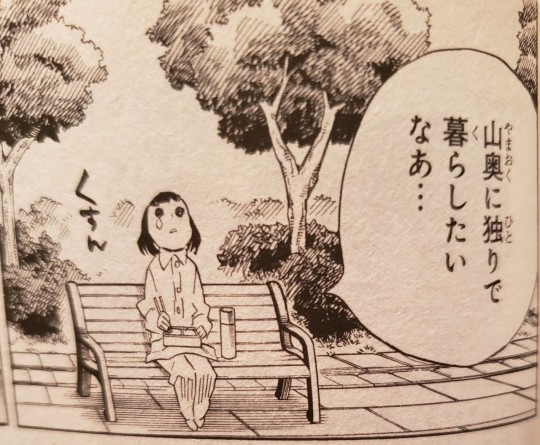
Just because he wants to be alone in nature doesn't mean he grew up on Mt. Kumotori, but I do suspect he has spent a lot of time there, because that's where the blue spider lilies--the subjects of his failed research--had come from. Although we don't know how this research started and who got the flowers in the first place, the potential connection is strong.
If he wasn't raised in that house, then maybe he and his family still go out there regularly to take care of it. After all, even if they don't remember who and they're unmarked, there are important graves to show respect to and take care of there. Maybe it was on a trip like that when Aoba discovered where the blue spider lilies grow, which put him on the botany path.
You know who he apparently didn't run into? Any Kamados, as he and Sumihiko didn't meet until Aoba was unemployed and Sumihiko was scolded by the police and they were both hanging out and depressed in the park.
Reason 8.
Tanjiro trusts Inosuke.
Entrusting Nezuko to Zenitsu is one thing--Zenitsu obviously would do anything to keep Nezuko safe, happy, and comfortable, but Zenitsu's heart isn't in the mountains. He's a city boy and doesn't like the inconveniences of mountain life, and clearly he doesn't show much initiative for the demands of keeping a mountain home. Tanjiro wouldn't expect this of Zenitsu, nor would he trust him with it, even if he'd trust Zenitsu with just about anything else.
In Inosuke's case, Tanjiro understands Inosuke at an intuitive level--what he needs to hear and be told, and what Inosuke's strengths are. If ever Tanjiro got the inkling that he can no longer take care of the house, or that he must prioritize taking care of his small children and partially blind wife, then he wouldn't think of anyone else but Inosuke who would be happier having that home for his own.
Inosuke sure wouldn't be happy at first, though.
That house is Kamado Tanjiro's house, and he doesn't want a house without Kamado Tanjiro in it.
But Inosuke, who has never had a traditional nuclear family, might come around to the idea of being the head of his own family, and having something normal and human like this of his own.
The Hashibira house, with Inosuke the head of the Hashibira family, providing for them with his labor.
I can imagine Tanjiro would run the idea by Aoi first, who would accept the responsibility as an honor, and maybe this would come after Tanjiro and Kanao had been a married couple on their own a while in the house first. The town where the boys sell charcoal is big enough that I can see Nezuko being pretty happy settling down there where it's close both to home and more along the lines of Zenitsu's tastes, but eventually...
Reason 9.
One way or another, the Kamado and Agatsuma families are both going to wind up in the heart of urban sprawl, far away from Mt. Kumotori.
It's only a question of when and why.
148 notes
·
View notes
Text

I was rereading my own meta post about Kanao's development recently, and it made it me really eager to do more with her. She is my muse lately.
More below the cut, of course.

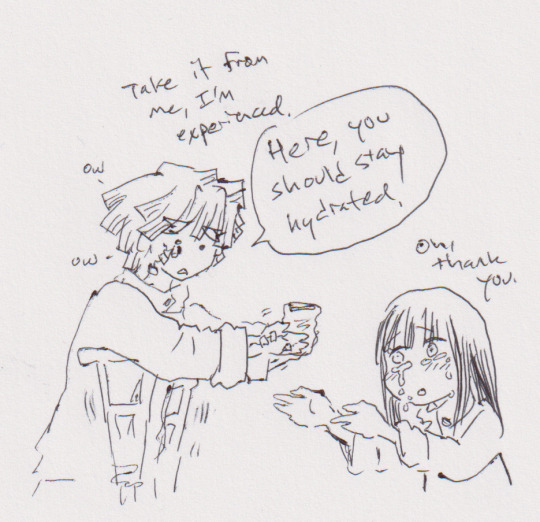
How did Zenitsu carry a cup over there while using crutches for two busted legs? Don't question it, a girl was crying.
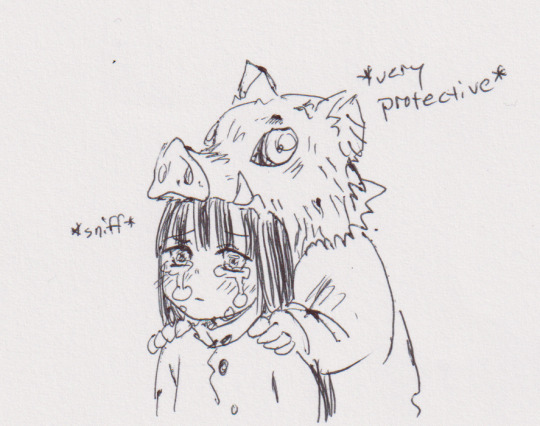
Is Inosuke crying too? Yeah, probably. But if you ask him he'll be utterly convinced of it when he says no.

Nezuko, the stand-in for the Kochou sisters smiling down from heaven.
And then of course the one responsible for this whole mess...

197 notes
·
View notes
Text
Yoriichi Type Zero has six arms because there was no other way to capture the movements Yoriichi was capable of.
Is this why Kokushibo has six eyes?
I've pointed it out before, but if that is the case, it adds even more irony to the "one" kanji in Kokushibo's eye (壱) being the same kanji used in Yoriichi's name.
131 notes
·
View notes
Text
I am incapable of hearing someone mention they went to one of the first tonkatsu and omuraisu places in Japan without thinking, "I wonder if Mitsuri went there." I am even less capable of watching a short TV segment about how heating up sweet potatoes is what brings out their flavor without thinking, "RRRREEENNGOKUUUU"
And I did start spinning meta about how "like a sweet potato, you cannot bring out the best in a person until you make them undergo a sort of trial by fire, and this all ties back to the 'purgatory' which the 'rengoku' name refers too. Wasshoi, wasshoi."
The brain rot is real.
75 notes
·
View notes
Text
I invite you all to consider
Tamayo & Yushiro in the background of Yoshiwara
--They had to leave their place in Asakusa, which wasn't far from Yoshiwara, but I bet they stuck around the same area if it was advantageous for trying to track Muzan
--Muzan visited Daki mere days before things went crazy, so they might even had tracked him there and were surprised to spot Tanjiro
--very surprised, what with that get-up
--they work in the background with a vague idea, or even definite intel that Tanjiro is tracking an Upper Moon, which they of course have an invested interest in seeing through, but also they don’t say anything to Tanjiro because they can't risk blowing their cover after all these years
--As Tanjiro fights Daki, Tamayo helps Koinatsu-oiran get to safety (this all started because I was curious how they might interact)
--As things get more chaotic they get caught up helping other injured people, which distracts Tamayo from seeing Nezuko in berserker mode
--But Yushiro might notice and then prevent Tamayo from seeing her, because if Tamayo were to try to do anything to help Nezuko it would risk her being exposed to an Upper Moon
--but also it would break her heart to see Nezuko like that, and Yushiro wouldn't want her to know until later. Or ever.
--even if they stay busy helping the last of the people who couldn't get away because they can withstand the physical danger of going through collapsed buildings, they will still be close enough to feel the force of the battle
--and then when Nezuko pops back out to absorb Gyutaro's final attack with her flames, Yushiro barely manages to shield Tamayo and get her to take cover in time to avoid being swallowed up in them
--Tamayo would be stunned to witness Nezuko's power, as terrifying to demons as the sun itself
--which plants the idea in her head that Nezuko may soon have nothing left to fear
94 notes
·
View notes
Text
Hantengu: As Bad As You Can Get Without Being Muzan
I've touched on this in old meta entries and I'm just going to wind up linking them here, but a friend got me going on this again today, so I'll state it again: Hantengu is one of the most insidious characters in this whole series, if you're going by sweeping themes of self-mastery which Gotouge may or may not have consciously intended.
For starters, I'm going to compare Hantengu to his polar opposite, Rengoku Kyojuro, mostly by referring you this post where I already explained how Kyojuro displays samurai-style idealized virtues of self-mastery, stoicism, and inner peace about death or aging. A common theme in oni lore is how letting one's passions run amok is what brings out the demon any person has potential to become, whether these passions are greed or worry or even joy. Kyojuro is very clearly a passionate person, but he's self-aware enough to know that his passions must be kept in check in order to benefit from them, and that means putting effort into maintaining them. He's seen how that can lead to burn out as in the case of his father, so he maintains his own balance by recognizing and accepting the harsh truths of any situation with as much grace as he can muster, recognizing and taking steps to overcome his own shortcomings, and recognizing and making a choice to "set his heart ablaze" instead of getting lost in frenzy.
Hantengu, on the other hand, lets his passions run so amok that they take their own physical forms, and even then no single one of them is ever consistently powerful enough to be sustained for long before he's spawned something new based on whatever new frenzy he's in. It's his reckless abandon of self-control that made him so demonically powerful.
There are other characters who lack self-control, though--Inosuke and Zenitsu are who they are because they are the perfect agents to introduce chaos to any scene. They gradually take steps to learn self-mastery, however--Zenitsu is hyperaware of his own failings, to the point of rumination, and Inosuke is hypoaware. However, at their core, their desire to do better by other people leads them down paths of self-improvement, a path which keeps them aligned with humanity as opposed to the allure of powerful demons.
Demons in this series display similarly admirable traits, though--Kokushibo and Akaza have striven as hard as any Corp member to improve themselves, for instance. Gyutaro and Daki might have had blatant disregard for others due to a lingering jealousy and hatred for how much better everyone else always had things than they did, but they have always taken active roles in standing up for themselves and trying to improve their circumstances.
If we dive into more loathsome, demented demons, we still see that they know themselves enough to own their faults, whether they see them as faults are not. Douma is quick to recognize his own lack of passion, Enma is unashamed as about what gives him pleasure and uses his underhanded, self-protecting tactics in order to play the long game in his strategy, Gyokko is an artist, and Muzan is perfectly clear and at peace with who he is and what he wants. Muzan's desires are so plain to him that it even opened up a believable opportunity for Tanjiro to feel sympathy for him in their final encounter, though Tanjiro made the choice not to.
Tanjiro never even entertained the notion of pitying Hantengu, though.
I'll come back to Tanjiro, but to borrow from this post about themes in KnY as they relate to oni lore: In many philosophies, even an excess of positive emotions can be detrimental, and people who follow those philosophies are instead encouraged to not given into any emotion too strongly. Likewise, the lack of a virtue can be bad, but an excess of it becomes a vice.
While the Ki-Do-Ai-Raku fearsome foursome represent the danger of unchecked, excessive emotions, Zouhakuten represents an excess of virtue, which turns it into a vice. From an outside perspective, of course Tanjiro was doing the right thing attacking a tiny oni, because this oni will go on killing people if he doesn't, but Zouhakuten focuses so intensely on the injustice of attacking the small and weak that he is ignorantly convinced of his own self-righteousness.
The other demons don't do this, particularly--they justify what they do, like Daki saying how this is just the way the world works that beautiful and powerful oni can do whatever they want because that is how the world works, but she doesn't claim her actions are righteous. Muzan also makes rational points--which Zouhakuten echos--about how the demon slayers drive a lot of the violence due to their own inability to make peace with their lot in life, and going out of their way to attack demons. However, as much as Muzan believes he is superior, he doesn't belief he is a god who can cast moral judgement on others, nor is he interested.
Zouhakuten, taking the form of a deity that fiercely protects the precepts of Buddhism and threatens those who defy it, makes the daring claim that he is just.
The Demon Slayers Corp members, at least those like Tanjiro, are guilty of the same thing. The difference, however, comes back to self-awareness. For example, Tanjiro is confronted with the question of whether Zouhakuten/Hantengu has ever eaten anyone in Tanjiro's life, and as he has not, Tanjiro must at least question if justice is on his side anyway in attacking Zouhakuten. It was an easy answer, but being mortal and easily killed for sticking his neck out by picking fights with demons, it's something Tanjiro continually has to question and reaffirm.
Yes, the answer is always easy for Tanjiro, and yes, there are Corp members who are only in it for the glory or the money (and these characters are not treated as heroes). However, Tanjiro must also continually self-reflect on his own weaknesses and failings. Taisho Secrets tell us he's even reviewing his training and battles in his sleep to analyze and learn from them, and we see his continual efforts to improve no matter how beaten down he's gotten. In the heat of battle he has to keep himself confident and focused. He's got to keep from beating himself up unfairly, and he's got to keep from getting over-confident, it's a balance to maintain and it takes practice to read oneself with clarity.
He's constantly having to practice self-mastery, which means Total Concentration of whatever strength he needs to pull from, including passions like righteous anger that make it feel like his heart and/or forehead are ablaze. It takes him practice to be able to keep rebounding, but he's got humility to be able to learn from others, take criticism, and analyze himself with clarity.
These are the virtues which Kimetsu no Yaiba extols, and which most separates the paths of righteous from the paths of those who who gave into their passions.
As a few other examples:
--Nezuko retains her virtues by recognizing her own weakness and focusing on self-mastery
--Rui lost himself in a feeling of entitlement, conviction in his own sense of justice, and disappointment in his parents. Or so he thought! That was all the result of running away from a truth about himself he didn't want to face; the fact that he was the one responsible for breaking his family bonds.
--The Pillars, with all their human faults, remain righteous because they could easily succumb to their own sorrows, angers, and self-loathing. The fact that they do not--however much these things have messed them up--and they keep striving to better themselves, for the sake of a conviction in something difficult to achieve otherwise.
Zouhakuten, instead of rising above his own shortcomings, is a deeper concentration of, a wallowing in those unbridled passions. Being so convinced of his own righteousness, he does not have any clear self-understanding, and therefore, has no inclination toward self-mastery.
He is, after all, Hantengu.
Hantengu made himself into what he is because he convinced himself of his own lies about his own helplessness, and this utter lack of self-awareness and his unchecked passions are what make him a demon. By doing nothing to improve himself, he grew out of control. And, ultimately, Hantengu is selfish. Everything must revolve around him and how he is the most wretched creature, the most powerless thing to ever have the harshness of the world thrust upon it. Among a cast of relatable demons, made victims of their own poor luck or circumstance or a desire to amend some wrong done to them, Hantengu is the worst because he got himself there for nothing but his own self-centered lie.
While all the demons have relatable traits which have flown out of control, he's the most realistically like someone we all know or have met. He's the most benign and hardest to catch, one whom many philosophical, religious, or therapeutic texts try to warn against for how his insidious fleeing from truth grows into something monstrous.
The scariest part is that the wallowing Hantengu might be closer than we think.
#and now I'm going to bed#can you tell I'm excited to watch Noh this week?#Hantengu#kny fandom theories and meta#by this logic Douma is also pretty bad but for nihilistic reasons#and at least Douma displays a willingness to change his mind if challenged#I don't care about anything ACTUALLY NO I THINK I LIKE YOU SHINOBU LOOK I DO HAVE FEELINGS AFTER ALL THIS IS NICE#and what's fun with Muzan is that we get to see his worldview challenged by panic#but also Muzan KNOWS he's a coward and OWNS THAT by trying to run away#AND I LOVE IT#I love all the tension from seeing the battle from inside his head#anyway#right#bedtime
164 notes
·
View notes
Text
Nezuko's Favorite: Konpeitou
It's time for Kimetsu Kitchen, and over-analyzing a tiny lore detail! And by tiny, I mean 1.5cm or smaller.

As already stated in the first fanbook, Tanjiro reminds us the Yuukaku Arc Taisho Secrets that Nezuko's favorite food is humans konpeitou, colorful tiny candies that are made almost entirely out of sugar. They are best known for their signature shape, with a bunch of bumps called "tsuno," that is... horns.

Aha, I see what you did there, Gotouge. So in that light, I'm not going to hold back wherever I see connections to Nezuko. First off, like Nezuko, konpeitou also comes in many fun sizes. Because of how the horns are formed with the candies bumping into each other and dripping onto the biggest protrusions, the candies have fewer and fewer horns as they get bigger.
We'll get into how they are made is a second, but first a brief history. Konpeitou, like castella and tempura, were introduced to Japan in the Sengoku period by the Portuguese missionaries. Warlord Oda Nobunaga was even presented with some earlier versions of this "confeit" that had anise at its core for a refreshing finish. However, after the missionaries were kicked out, they disappeared for a time, until Edo-period townspeople in Nagasaki (with access to trading with the Dutch) developed a pan-fried version, which they named 金平糖 (gold-even-sugar). Konpeitou were a rare treat accessible only the rich and powerful, such has the emperor using it for special occasions, until a new and easier method with rotating frying pans was patented in 1903. This was already 36 years into the Meiji period, and Nezuko would had been a toddler.
The first konpeitou factory opened in 1907 in Osaka, which is when they really took off as a wide-spread treat, including being sent abroad in soldiers' rations. The first ones were not flavored, they were purely made of granular sugar and sugar syrup (a mix of sugar and water, so yay, more sugar!), and they came in four different sizes. However, the first variations came when they made a mix of four basic colors to reflect the seasons: pink for cherry blossoms in spring, green for summer greenery, yellow for the autumn leaves, and white for winter snow.
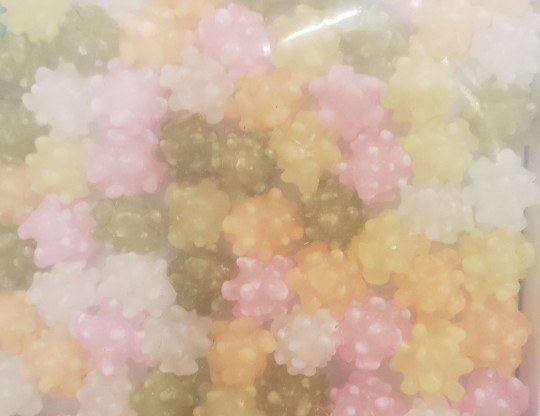
(The closest example I saw to the colors Nezuko might had had available, don't mind those orange ones.)
Throughout the Taisho period they gradually gave way to more popular sweets like ice cream and chocolates, but when Nezuko was a 12-year-old likely around 1912~1913, these would had been widely available and popular.
So how are they made today? Still mostly in Osaka, there's only about 10 factories in Japan that produce them. But only about 5 in Portugal that do, so no wonder people assume they are a Japanese invention! Although you can still find them as purely sugar-flavored and some cafes likes to use them instead of sugar or sugar cubes, you can find them in a very wide variety of colors and flavors now. Basically, if it can be dissolved into syrup, you can color or flavor konpeitou with it.
Konpeitou starts with granular sugar, turned twice a minute in tilted frying pans that are 180cm across at 75 degress C. Every few minutes it gets coated with a scrap of syrup, which gradually makes the candy grow bigger and bigger. It sounds like a simple process, but it takes a lot of patience and practice to get the precise humidity, temperature, timing, and movement to attain a translucent appearance and smooth texture with a pleasing array of horns.
If there is one character in KnY who is extremely patient and can pour that sort of effort into developing something, it's Nezuko. Konpeitou grow only 1mm per day (so it takes two weeks to make a batch of large konpeitou), but that ongoing, dedicated growth is very auspicious, like... hmm. Like what the asanoha pattern on Nezuko's kimono symbolizes. I've always assumed the vines in Nezuko's demon crest symbolized the same thing.
Alright, now to turn this into a Kimetsu Kitchen blog. If you are in Osaka prefecture, you too can join a very brief konpeitou making class to add the finishing touches to a little batch of mostly-finished konpeitou! You get to choose the flavors and colors, and for extra money, you can even add edible gold flakes or get cute jars to put them in. I got to make two batches, one based on the color and flavor already in the first batch. I was concerned out pink and green might mix, so I went with pink followed by yellow for a nice nod to Zenitsu's efforts in Kimetsu Academy to give her the perfect konpeitou. However, I wound up with a nice shade of peachy orange like her hair, and I'm sure Zenitsu doesn't mind.

I call the flavor "drink bar" because I thought a non-pick flavor like melon would be ironic and I wound up with a mix of melon and cola. It's pretty good.
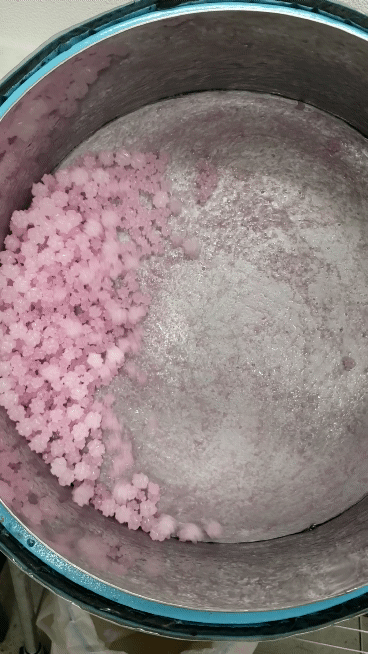

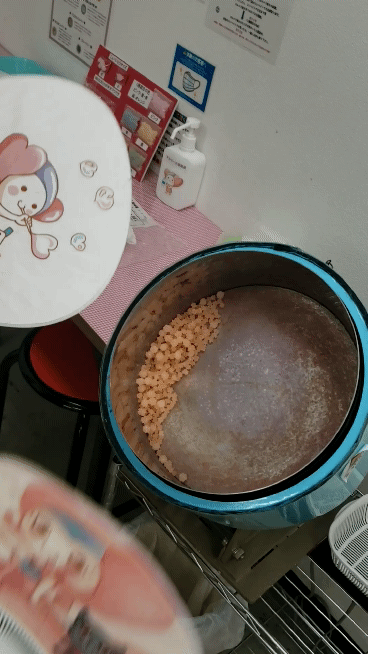
The base konpeitou was purely sugar flavored and white, but with tiny ladles of syrup with food coloring and flavor added and stirred about ten seconds at a time, the shape also gradually changed as the horns got more pronounced. It really is up to taste how little or how much you want to add, they're very versatile once the basics are formed.
97 notes
·
View notes
Text
Kakushi Headcanons
--Maeda is the Douma of the Kakushi. Nobody can stand him but he's too good at his job to get rid of him. He probably churns out uniforms so fast that no one can catch the unstandardized ones.
--Gotou got a girlfriend shortly after Muzan's defeat. It was a Kakushi he long had a crush on, and she finally fell for him when he drove a car into Muzan. Now that they are retired they go on dates to cute cafes and stuff, but the relationship progresses slowly because she's so bashful at the sight of his full face instead of just his eyes.
--Kazumi, after losing Satoko and witnessing Tanjiro defeat the Swamp Demon, becomes a Kakushi.
--Not my theory but one I've totally adopted: Sayo became a Kakushi looking for a chance to apologize to Himejima, only managed to hold his hand in the end.
--Many Kakushi can use basic Breath technique even if they didn’t wind up being good at swordsmanship.
--While they all are expected to be flexible with any task, many tend to specialize. The laundry team is really hardcore, they are a gold standard in Kakushi team efficiency.
--The girls at the mansion weren't actually supposed to know Gotou's name, but once that got spoiled he wound up getting assigned a lot to work there.
--A lot of the intel the Corp has on demons is thanks to Kakushi (at least, the fanbooks are written that way). They have worked just as hard as Pillars on tracking down Kibutsuji Muzan and are masters are hiding their presence; there have been encounters such as a customer who witnessed Entertainer!Muzan and an employee of the pharmaceutical company that adopted Child! Muzan. Never got close enough to verify anything more than "that's a demon, at least I know that much" before Muzan slipped away.
--One of the Kakushi got carried away with a new faith while trying to infiltrate the Eternal Paradise cult until their correspondent showed up to slap sense back into them. That was right before one of the times Douma moved his cult to a new place, so they lost him.
--Taisho Secrets tell us that the Kakushi were introduced around the time in the Sengoku period when Kokushibo nearly eradicated the demon hunters. That lines up nicely enough with the existence of (what we now call) ninja that I'm willing to think they found a lot of recruitment among decimated ninja villages.
--Among the Kakushi, there are people who had reasons to hide their identify and start over in life. Runaways, convicts, etc. Many of them had the same "come to Oyakata-sama" moment that the Pillars did.
--Kakushi have such an in-group style of communication with so many coded references that other Corp members listening in would be totally confused. It remains a habit even in retirement.
142 notes
·
View notes
Text
Since Daki and Tecchikawahara have both stated it was, as the swordsmith, Haganezuka's fault that Tanjiro's sword got so chipped in battle, I've been asked if Haganezuka is indeed a bad swordsmith. At the time I said that Haganezuka is a fine swordsmith, albeit a perfectionist surrounded by perfectionists.
However, I came across an interesting comment from real life master swordsmith Asano Taro in this video:
"Katana is a perfect instrument. It is perfect in its creation and the way it looks. The theory behind its creation is also perfect. It doesn't have any faults. And if you use it perfectly well, it will cut anything with perfect precision. But if your spirit and movements are not at peace, the katana will bend or break instantly."
He goes on to say that the samurai is the one at risk for damaging the katana if he isn't mindful of himself, and Haganezuka would be quick to join him in blaming the user for damage, but what with Haganezuka being prone to fits of passion, I'd like to reconsider the question of Haganezuka's skills and final product.
It bears restating that while the smith gets a lot of credit for forming the iron into the blade, there are many other entirely separate and necessary specialists who contribute to the completion of a sword--the engraver, the artisan who makes a sheath, etc. While we see some evidence of crossover in the production of swords in KnY, we don’t know if there is any division of labor in the swordsmith village, or how much. We're going to come back to this point, but for our purposes in this post, we'll focus on sword polishing as a separate discipline.
In historical context, sword polishing was respected as a unique art as far back as the Heian era, and even though the sword production industry took a hard hit when swords were banned in the Meiji Period, they nonetheless were popular as works of art. This means that sword polishers were still in demand, more for bringing out a sword's beauty than for sharpening its usefulness. One famous sword polisher of the Taisho Period, Hirai Chiba, was said to be the sort of genius that only comes around once in every two hundred years, and he could make even the oldest, most decrepit swords glisten, but his methods were so genius that if others tried to further polish his work, they had a tendency to ruin it. The techniques are as unique as brushstrokes; we saw Haganezuka hard at work at a series of rough and primary whetting against large whetstones, but Muichiro didn't let him even finish the first part of initial whetting. That's to say nothing of getting to the series of small tools, many of which are so minute that they can only be worked with a craftsman's thumb.
We see some of the attitudes of the Taisho Period in the light novel chapter in which Tecchikawahara tries find a wife for Haganezuka, but she doesn't appreciate Haganezuka's career because swords aren't necessary in modern society. (It still baffles me that Tecchin thought a woman with these sentiments should be married into the swordsmith village, but he did choose her purely for having a cute photo.) She tries to convince him to switch to making kitchen knives or tools instead of barbaric weapons, but Haganezuka affirms that it's an honor that his swords are used by someone who puts his life on the line to protect others' lives.
So, is he a good swordsmith or not?
Our protagonist assures us he is. However, I've heard it said that you should strive to be the person you dog thinks you are, but perhaps it is higher standard to try to be the person Kamado Tanjiro thinks you are, so we'll set this aside.
What's more revealing, perhaps, is that Urokodaki already knows Haganezuka pretty well. Since Haganezuka is 37 and Urokodaki was in his prime at least 47 years ago when he trapped what would become the Hand Demon, it's unlikely that Haganezuka has ever produced any swords specifically for Urokodaki. Possibly Haganezuka's father did, in which case Urokodaki might had been familiar with little Haganezuka's upbringing. But, if Urokodaki is familiar with adult Haganezuka's work and personality, perhaps he's seen Haganezuka deliver swords to Final Selection graduates before... which might mean Haganezuka is Giyuu's swordsmith, too. If that's the case, I'm willing to bet Giyuu's never earned any special ire.
However, let us not forget that Haganezuka likes Tanjiro because Tanjiro keeps requesting swords from him. Other swordsmen haven't been able to deal with Haganezuka's personality and requested swords from other smiths. Giyuu could very well be among those swordsmen who quit this artisan, and a series of people being unable to look past his personality and appreciate his work doesn't reflect well on Haganezuka as a craftsman.
Back to Urokodaki, though, he's always the one who blamed the swordsman for wear and tear to the sword. If he ever felt Tanjiro got a bad sword, he'd likely have told him so and put in a complaint, making a more valid reason to request a different swordsmith.
To recap the post where I first considered this question, I think a big issue with Haganezuka's fervor is that he was raised by, and presumably taught the most incredible swordsmith in the village. Tecchikawahara may have been hard on little Hotaru because he was talented, and therefore he was dismissive of anything less than genius.
So then where was does genius come into play?
Oh yes, with the beautiful Sengoku era sword, and Haganezuka's polishing of it.
Let's take a step back to appreciate this element of the process in context, and assume Haganezuka is familiar with every stage of the process, and more skilled in them that you or I can ever hope to me.
First, Haganezuka makes sure to make sure Tanjiro knows about the special iron his sword is made of--and since Haganezuka and Gotouge thought that was important, I thought it was important as a KnY nerdery blog to make sure all of you appreciated this too. However, due to the labor intensity of the process of making iron sand into lumps of ore, I suspect Haganezuke may not usually be involved in this part of the process, even if he may have some experience with it.
When it comes to other elements besides the smithing, he perhaps wasn't a preferred artisan for things like making hand guards as the Rengoku clan likes them, or someone who had the right to engrave 悪鬼滅殺 ("eliminate all evil demons") on the Pillars' swords; perhaps there were village specialists, or other swordsmiths who improved their engraving skills because they were responsible for Pillars. Since Tanjiro didn't need a particularly crafty sheath, I'm inclined to think it was either average craftsmanship if Haganezuka made it, or it may have been outsourced to someone else in the village.
However, let's pause here on sheaths. Shinobu's Breath technique works due to the specialized sheath, so her sword and sheath must both be extremely high caliber. Tecchikawahara is credited with them, meaning the greatest swordsmith is adept in multiple disciplines. Tecchikawahara's son is as well, for he developed a special sheath for Iguro to draw his curvy blade.
I bring this up because Tecchikawahara has a son, presumably, the heir to his techniques. Although adopting a son to become an heir to a craft was common even in the aforementioned Taisho craftsman Hirai Chiba's circle, we can infer that Tecchikawahara did not consider Haganezuka Hotaru an heir, even though he raised him since the age of two.
But?? What is this in Chapter 105?
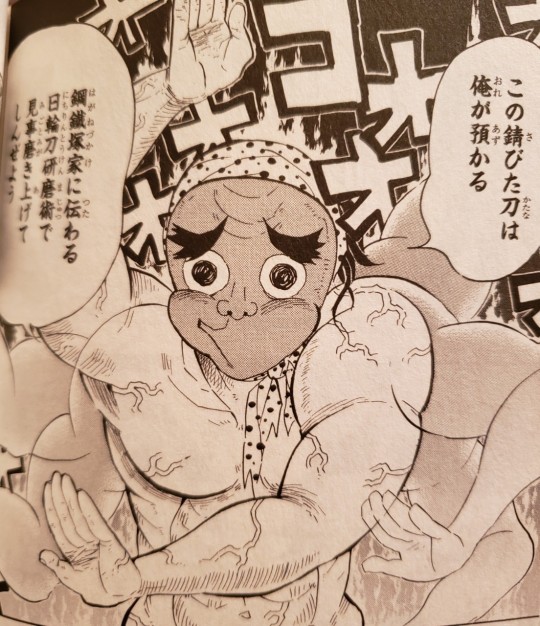
The Nichirin Blade Polishing Technique Passed Down Through the Haganezuka Clan??
Okay, but... Hotaru-kun, your dad didn't raise you, how did you learn these techniques??????
Whatever they are, Haganezuka has full confidence in them, which comes in contrast to how he was feeling about his smith abilities at the time. He was so upset about how his faulty blade might had put his favorite (only?) client in danger that he was off in the forest putting himself through training, the likes of which we can only imagine. If, as swordsmith Asano said, imperfections in the self may risk damage to the blade, does this mean his hot and volatile personality was being reflected in the metal; even if he was totally absorbed in the process, what there still some tension in his muscles revealing his excitement, shaking the delicate blade as it formed? Maybe, Haganezuka always saw something in his own work that he knew was lacking, and maybe Tecchikawahara has always seen it, too.
After all, Haganezuka knows very well how to appreciate good work; he was so absorbed in admiring a rusty sword that he could ignore an Upper Moon wanting to eat him. He could tell right away that it was likely good Sengoku era iron (historical note: we don't actually have good enough records to know why Sengoku era swords had higher quality iron, but it's possibly due to imported iron). Despite having no idea who the swordsmith was, Haganezuka could probably feel the strokes of his hands, like how a skilled calligrapher can see the pace at which someone moved with the brush, or how a master pianist can imagine the movements of the hands at someone else's keyboard. Haganezuka credited that mystery swordsman with choosing and making the engraving himself, and imagined him at work at a whetstone, thereby implying he'd have also done the polishing himself. Like how the tradition of engraving Pillars' swords came later, this may also be the origins of Nichirin blade swordsmiths taking more ownership of more parts of the process than their regular swordsmiths counterparts.
That said, like they have their unique styles and pride, they also have those things passed down in the family, and that might make certain artisans more specialized in some areas than others. If the former master of the Haganezuka techniques had no heir other than Hotaru, Tecchikawahara might have tried to amend the relationship between child and parent and encouraged Hotaru to apprentice under his own father.
So then what of the former Mr. Haganezuka now? Well... in Chapter 105, Tanjiro goes on to orate to Genya that the special sword polishing process takes three full days and nights (funny, so does making the tamahagane, but that's also requires a teams to constantly feed the fire). This polishing method is extremely taxing on the person doing it, and as Tanjiro was told, some people have even died doing this. So, you know, maybe that's some good angsty fanfic material if this has happened in recent swordsmith village history.
In other words, Haganezuka was already putting his life on line before Gyokko attacked.
However, whether it was a result of his recent solitary training in the forest or in his conviction in the Haganezuka Family Polishing Techniques and his own execution of them, he betrays no worry about whether or not he'll be able to finish, and insists that this task be entrusted to no one other than him.
Which is to say, Haganezuka may be an alright-to-very-highly-skilled swordsmith, but his true strengths may lie in what's usually an entirely separate discipline.
From a narrative and character arc perspective, this means that Haganezuka has been somewhat freed from the pressures to live up to Tecchikawahara's standards in overall sword production, especially since he can't manage to keep many clients, or perhaps hasn't managed to keep anyone but Tanjiro. With Tanjiro as his perhaps only client, that means he serves a different purpose for Tanjiro now, as Tanjiro is the owner of such a fine sword---like how no one could work with genius Hirai Chiba's techniques, likely Haganezuka is the only one who can be trusted with the care and upkeep of such a valuable sword.
He's found his true calling, one might say.
Not that this makes me think he'd give up making swords--not at all, he loves them too much! But maybe in feeling assured that he's serving Tanjiro's needs, it can allow him to relax more, and enjoy the process, and relax knowing that Tanjiro's not going to chip his new and possibly more creative works.
For Tecchikawahara, who presumably already has the heir to his own techniques, seeing Haganezuka reach his full potential in the Haganezuka tradition may be what pleases him more than any unfathomably unbreakable sword.
139 notes
·
View notes
Note
Do you think Kokushibo ate his brother’s dead body, gave him a burial, or simply left him to rot? Since it was clear that Yoriichi was born different, I always headcanon that his body was so special that it could give a huge boost of power if a demon managed to eat him. But on the other hand, maybe Kokushibo’s underlying affection for Yoriichi was enough to prevent him from desecrating his brother’s corpse further. Or the pain was too much for him to bear right then so he just ran away instead?
In Chapter 178, after the frustration of seeing Yoriichi's life simply extinguish and expressing that frustration by cutting him to pieces (he didn't even get the satisfaction of killing him, argh!), and then seeing the wooden flute Yoriichi kept all those years, Kokushibo began to cry and thought the following: "Enough with this. I hate you. Just seeing your face makes me want to vomit."
This makes me inclined to think he didn't have appetite for eating Yoriichi, no matter how powerful it might had made him, even in Yoriichi's old age (though since Yoriichi reached the end of his natural lifespan, perhaps it wouldn't have had the same effect as eating him in his prime). Kokushibo goes on to say how what he most wished he could forget was Yoriichi's face, how the sound of his voice made him angry, how Yoriichi was always out of reach. Even though he retained bitter affection for Yoriichi, his frustration at him prevented him from having the respect to bury him, I think. Kokushibo wouldn't stoop to that, and probably turned around and left.
Nature-loving Yoriichi was probably left alone to be a part of it.
79 notes
·
View notes
Text
While Mitsuri playing with little!Nezuko is precious, I really love seeing big!Nezuko with Mitsuri too. They took to each other so naturally. It's hard to say if Nezuko's thought process ever went this deep, but as a very physically powerful girl who cares about protecting humans like they are her own precious family, Mitsuri is the most likely character in the series to serve as a role model for her.
The below scene takes place as Mitsuri swoops in to rescue Tanjiro, whom Nezuko watched helplessly about to die, so this expression could simply be read as relief. However, every time I see that look on Nezuko's face, I see her filled with admiration for her hero, too.
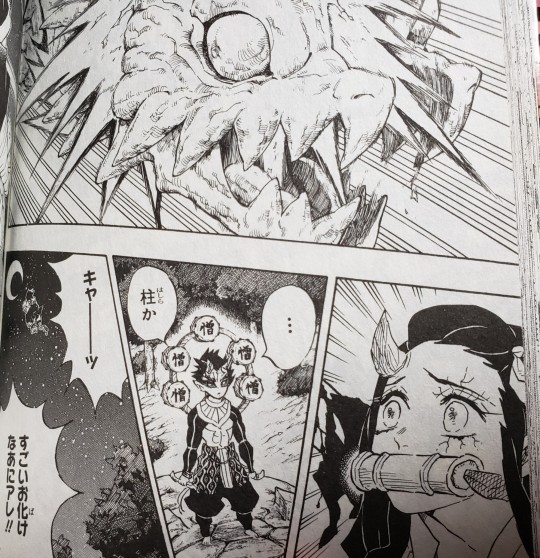
Nezuko is just as alarmed Tanjiro when Mitsuri takes an Upper Moon attack to the face, and was still stuck, even! But who was it who got to Mitsuri first?

Yes, yes, I know the boys were fast, but let me bask in giving Nezuko credit for this rescue.
My goodness, I wish we could had seen this unfold more! If Mitsuri is like the older sister Nezuko never had, she'd perhaps had looked to her like that even if they met under circumstances in a world with no demons. Nezuko spent more time with Shinobu, a calm and "cheerful" presence, but it was Mitsuri's brightness that allowed Nezuko to totally relax and be playful. Even as a mature, responsible older sister, human!Nezuko probably would benefit in a similar way.
For Mitsuri too, she's totally open and herself around Nezuko, there's no pressure or self-reflective shame about her motives for being in the Corp or for being less put-together than the other Pillars. Nezuko sees and adores Mitsuri for exactly who she is, making Nezuko someone in whom Mitsuri has found a home, like she always sought by using her strengths in the Corp. If Nezuko did in fact admire Mitsuri as a physically strong and loving role model, it breaks my heart to think Mitsuri might not had realized that.
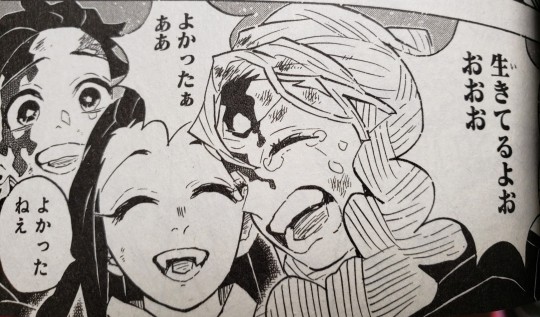
#kanroji mitsuri#kamado nezuko#kny fandom theories and meta#sometimes I think of characters as role-models for adjusting my own attitude#on day as I was grabbing my Mitsuri hand towel and mulling over something I asked myself how she would handle things#and immediately my brain shouted back#SHE'D TAKE THE BLOW WITH HER FACE
190 notes
·
View notes
Text
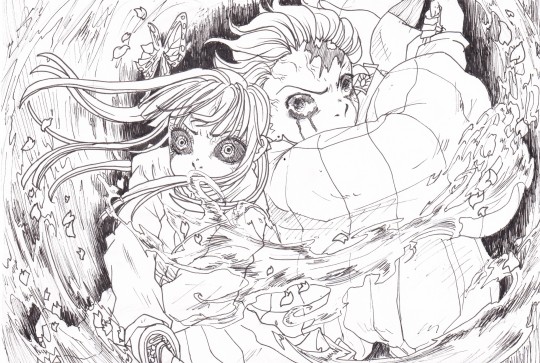
"The obi have increased... Thirteen of them. If I avoid them that might spread more damage. But what is this? They look really slow." -Tanjiro, Chapter 82
"Pushing your kinetic vision to its limits makes all the surrounding movements look dull and slow. The pressure it puts on the eyeballs causes bleeding which dyes the sclera red." -Kanao, Chapter 162
---
Since all the Breath techniques originally branched off of Sun Breathing, I'd like to think Sun Breathing encompasses the basics of all the other Breaths, even if it didn't specialize so deeply in all the aspects they'd later take on and polish to their utmost potential.
(Omake below the cut.)
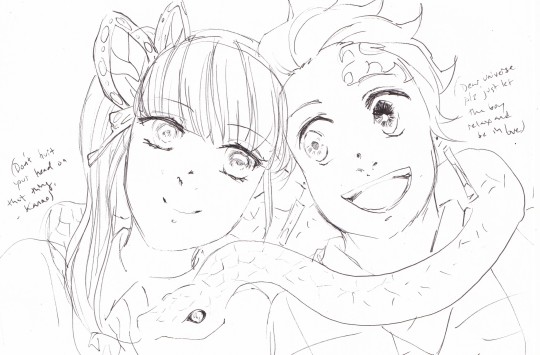
But now I've got to wonder if this was where the Kakushaku-no-Ko lore came from which said having red eyes was an auspicious sign! Was it just bloody eyes from swordsmen who survived with unlikely victories?
#TanKana#Kamado Tanjiro#Kamado Tanjirou#Tsuyuri Kanao#Kaburamaru#Tanjiro x Kanao#my art#my nice art#kny fandom theories and meta
247 notes
·
View notes
Note
How frequent do you think are cases where a member of the Demon Slayer Corps ends up being turned into a demon?
With the following clues from canon, I think it's safe to assume that between Kokushibo and Kaigaku, nobody! Or at least, not Breath users. Maybe if Muzan had encountered some bizarre abilities like Genya's he's have wanted to try it out, but it's stated in two places that Muzan doesn't have interest in turning Breath-users into demons.
In Chapter 187, Muzan starts out his encounter with Yoriichi by very ominously stating that he "no longer has interest in swordsmen who use Breath." What he means by this is that he's already satisfied his curiosity by changing Kokushibo (which Yoriichi would not learn until after the encounter.)
Furthermore, regarding that experiment on Kokushibo, in Chapter 145 Kokushibo tells Kaigaku that he took a full three days to transform, and that in the case of Breath users, it takes a very large amount of blood from Muzan to be effective. Since Muzan wasn't interested in trying it on others, Kokushibo's awareness of this as a rule may come from only from his own personal transformation experience, and extremely talented understanding of his own anatomy both as a Breath user and as a demon who can see the Unseen World. Using Breath technique fundamentally has an effect on the body which perhaps makes it more resistant to Muzan's blood--hence the amount necessary to overcome that, like how Tanjiro reacted the first time vs the second time--but once the transformation occurs, it results in extremely powerful demons.
The second place Muzan's disinterest is stated is in the second fanbook, on the segment about Muzan's perspective on the Kaigaku bio page: "Besides having Kokushibo's recommendation, [Kibutsuji's] high expectations of him prompted him to promote him to an Upper Moon. However, it seems Kibutsuji already did not have interest in demons who can use Breath technique."
That essentially serves a reminder of Chapter 187, while also showing us this lack of interest hasn't changed in the last few hundred years.
Perhaps Kokushibo has recommended other Breath users in the past who didn't wind up surviving the transformation, but in each of those cases, he'd have sought permission from Muzan first (and everyone Akaza asked said no, haha). We know all demons besides Yushiro are made with Muzan's will, whether in person or from afar, even though Giyuu's wording in Chapter 1 seems to imply that demons can be made accidentally from blood getting inside wounds. If this were the case, Corp members would probably be very high-risk. This was my own misunderstanding for a while, too! However, a couple of very frustrating romps through canon have helped debunk this.
72 notes
·
View notes
Text
"The Legend of Zenitsu" Arcs
When I first read the final chapter of Kimetsu no Yaiba I had mixed feelings about the saccharine modern day epilogue, but one detail I loved was the inclusion of “Zenitsu-den” (The Legend of Zenitsu), for although it was kind of funny that he’d make himself the focal hero, it was touching that he’d be the one to think to record everything that the Demon Slayer Corp together accomplished. Zenitsu always spent so much time in his head mulling over things that he’s nice to see him give form to his thoughts. It was bittersweet that they live in a time so peaceful that his own great-granddaughter would think everything about demons was entirely made-up, and if Yoshiteru was heavily implied to be a reincarnation (though this was never stated), it was nice to see him being proud of himself, in a roundabout way.

But then the second fanbook came out about eight months later with a rather unsavory version of Zenitsu writing his magnum opus. We see through Tanjiro’s assessment that as opposed to being a thoughtful chronicle of the battles the Corp underwent, it’s a collection of cringe self-insert fic and not even written in a way that makes sense. I was very disappointed by this, but as time went on I came to embrace it; the boy likes his indulgent escapism and he writes 79 volumes of this over the course of his life. Let him have his fun; one way or another I’m sure he was manly for his wife after getting a verbal slap in the face from his future brother-in-law.

Well over a year later, we got a little extra information about the contents of “Zenitsu-den” at the Gotouge exhibition, including titles for the story’s 25 arcs, which I have to assume were written over the course of Zenitsu’s life. Here’s the thing: “Zenitsu-den” is not a historic record or indulgent fantasy, it’s both.
“Zenitsu-den” is described as absurdity with events that don’t even fall in chronological order; but its swordplay and descriptions of demons are masterfully vivid and its developments may sometimes keep you on the edge of your seat. On the other hand, many sections are clearly lacking in explanation, and the author doesn’t even keep track of all the details or side character names. Speaking of the side characters, it’s said that the characters whom he depicts as the ugliest (men who are close to Nezuko who he resents for this) are actually handsome in real life, whereas the author depicts himself as a slim but tough man, but is said to be a chubby sweet tooth in real life who has trouble growing facial hair. His wife Nezuko is described down to the very number of her eyelashes. We know from Tanjiro’s comments in the Fanbook #2 comic that Zenitsu took seven pages each to describe himself and Nezuko (including adding somewhere that he, Zenitsu, is 2.7 meters tall), whereas other characters were lucky to get maybe two lines of messy introduction. While the author claims everything in the story in true, it’s almost entirely flights of fancy, and it takes a lot of dedication to read the whole thing and make any sense of it.
(Side note: It’s not clear if “Zenitsu-den” was ever published or if the only copy of each of the 79 volumes remains Agatsuma family property. What we do know that Zenitsu made his own illustrations, and the realistic paintings which his wife modeled for were things that people repeatedly offered him money for. He was known to have screamed “WHO WOULD SELL THEIR OWN WIFE” as his pants ripped apart at the butt because he was so worked up. Really unnecessary detail, but this is the Taisho Secret our favorite alligator chose to share.)
As for when Zenitsu began writing, it was sometime after settling into the Kamado household. The impetus was Tanjiro giving him a stern warning to stop doing shameless things like pretending he’s in pain so that Nezuko will rub his legs for him (and therefore stop paying attention to Inosuke). Tanjiro seems to interpret this as Zenitsu diving into his own fantasies after having been scolded. Even if Zenitsu might had been a bit upset with Tanjiro at first, Tanjiro is nonetheless the person whom he is most eager to show his writings to. In presumably a short time, he’s written a lot.
If we assume Zenitsu never edits and just wrote everything in the order of the arcs, then based on the content Tanjiro encountered with demon!Inosuke and Princess!Nezuko (and thief Sanemi somewhere or other, which I must assume is due to Zenitsu cheesed off about Sanemi sneaking into their home and leaving presents), then we can assume he already wrote the following arcs, though I’m more included to believe he inserted later writings into earlier parts of the story order.
The Birth of Zenitsu Arc
The Demon Slaying Arc ~Fated Encounters~
The Heavenly Maiden Arc ~I Am Willing To Die For You~
The Tastiness of Nezuko-chan’s Cooking Arc
Warring States Nezuko-hime Arc
The Life of the Man Who Loved The Spirit of the Plum Tree Arc
Zenitsu the Ninja Arc ~Love Like A Flash of Lightning~
Battling the Boar ~The Leaves of Darkness Flutter~
That’s… a lot. Like, over a third of the arcs.
Not that we know how long these arcs are, but if Demon!Inosuke is the boar they face in that arc, then Tanjiro was put through a lot of reading. That story didn't even have "Arc" in the title. Then again, it’s just as likely that this Boar was simply the leader of the terrible boars whom trouble tanuki!Nezuko. Anyway, the arc dedicated to Nezuko’s cooking seems truly inspired.
To go back to that “Spirit of the Plum Tree,” this reminds of a certain god of scholarship who is also a vengeful lightning god. It’s said that when Sugawara-no-Michizane was banished from the Heian capital, the spirit of the plum tree which he loved from his garden flew to his side in exile. I get the feeling that a lot of Zenitsu’s writings are self-inserts for himself and Nezuko in other stories he liked; Sengoku/Warring States and Ninja stories would had been popular fiction Zenitsu had grown up around, and there’s no end to folk tales of Tennyo/heavenly maidens. Also, the spirit of the plum tree is the example of how beautiful his illustrations are when his wife served as the model.
What with those first two arcs having relatively grounded topics, I have to wonder if Zenitsu started with realism in mind and then got flying off the handle. After all, fighting demons was a pretty big deal in his real life and his descriptions of demons were said to be remarkable, so I’d like to think that volume in particular was more grounded in true events than others (I suspect Yoshiteru was (re)reading this volume, or he had finally made it to the end of Volume 79 when Touko kicked him in the back). And, since there is a lot of sad content in that arc, it’s like he buried that second arc in all the more fanciful, triumphant arcs that came after it. Then again, if these writings are Zenitsu’s coping mechanism for a life that never usually went well for him, then it’s just as likely the circumstances of his birth were of godlike nature as opposed to the sad, short story of an abandoned baby with no name. Anyway, Zenitsu kept writing:
Beautiful Swordswoman Nezuko Arc
The Golden Dragon Wandering Alone Arc ~Go And Rescue Nezuko!~
Botamochi from Zenitsu Arc
If we assume the content is similar to how Zenitsu twists real life people and events to make himself look better… I really wish I knew the context for that Botamochi one. Botamochi is another word for Ohagi. Somehow, this chapter is inspired by Sanemi. Is this where he takes in the thief persona, sneaking in and taking Zenitsu’s sweet snacks instead of leaving them? Or, if it implies someone presented ohagi, is this a story about Giyuu and Zenitsu hijacked it??
As for that Golden Dragon, is this a reflection of all those solo missions he went on, separated from Nezuko? Or was there any period of separation in real life? It’s always been a headcanon of mine that Zenitsu moved out of the Kamado house first to set up a nice place for his wife to live before they were married, so maybe in a period like that, however short? Or did he write that whole arc while she was on a visit to the Butterfly Mansion?
Also, is Zenitsu giving us the reverse AU we all dreamed of for Nezuko? I love and adore that he gives her a chance to be badass in these stories too. Speaking of being badass, Zenitsu seems to have some idea what he was like when he was asleep, as perhaps reflected in the next arc. Maybe this one was truer than he knew:
Rumble of the Knock-Out Secret Swordsmanship of Zenitsu Arc ~The Legendary Man’s Eyes Shine With Light~
And while he’s thinking back to other experiences in his demon slaying years…
The Potato Feudal Lord Arc
Wasshoi!! Rengoku-san, is that you!?!? And does the following have any Pillar influence too?
Little Mouse-Boy Zenitsu Arc
…nahhh. Speaking of Pillars, though, Tanjiro pointed out in the earlier arcs that Zenitsu was already the Thunder Pillar, though he didn’t particularly do anything cool to earn that title. We have no idea how old Zenitsu is by the time he’s writing these middle arcs, or what amusements he sought while having to navigate life as an adult, as presumably as the head of a family. He might had wanted to go back to being babied a little.
The Dragon Palace Arc ~Eternal Nezuko~
Reference to Urashima Tarou and his time spent with Otohime at the underwater palace.
Sitting In A Happy Circle and Boiling Tea in Our Bellybuttons Arc
I chose to literally translate this idiom for "doing something ridiculous." Since the Thunder God is known to steal bellybuttons, I wanted to keep the reference there.
The Future Holds Zenitsu Arc
Are you embracing adulthood, Zenitsu-kun?? Alternate translation ignoring the implied idiom in favor of being more literal, “Zenitsu Just Up Ahead Arc.”
Pianist Zenitsu Arc ~Nezuko Like Raindrops Dripping from the Eaves~
Please tell me he was a pianist in real life. Please pretty please.
Also, it's purely headcanon, but I want to think Yushiro found himself reading this one day and enjoying it before it occurs to him who wrote it and who these characters are and he feels disgusted by Zenitsu out-simping him.
The Gods’ Shrine Maiden Nezuko Arc
She really gets to try everything, doesn’t she.
Zenitsu Makes A Fortune in A Single Stroke, Wahaha! Arc
Wishful thinking? A spin on the truth of his youth?
Life or Death Struggle! Zenitsu the God Arc
Is this where he writes about the battle with Kaigaku? Or is this just a setting in which to bring back Miko!Nezuko?
Big Romance☆Glittery Zenitsu Arc
It has no canon basis, but I like to headcanon that around the 1970’s, Zenitsu takes Nezuko to Paris as a sweeping romantic gesture and takes photos of her the whole time. It is now my headcanon that Zenitsu wrote about himself glittering in Paris, being the best romantic partner ever. We’re winding down to the final arcs, though, Zenitsu’s got to be getting old by the time he wrote this one…
Master Zenitsu Arc ~The Appearance of a Great Teacher~
We know from Fanbook #2 that the modern day kids know Breath Technique, as they were preserved by performing them once a year at a shrine. This means Zenitsu satisfactorily taught Thunder Breathing to a successor. As many of his writings turn real life situations around from making him look bad to making him look good, I have to wonder if he was covering up his shame at being unable to pass on all the techniques Kuwajima taught him, or if he reached a point where he felt truly satisfied with having made a good teacher of the Thunder technique.
And speaking of getting up in years…
I Will Be In Love With You A Thousand Years Arc ~Again, Even If We Are Reborn~
This is the part when I cried out. You guys.
NEZUKO DIED FIRST.
Like, I already had that guess, if we interpret Touko and Yoshiteru as their reincarnations. I’m glad that was never expressly stated even if it was heavily implied, because there’s nothing nice about former lovers being reborn as siblings, especially bickering ones. But, with Yoshiteru being so close in age to Touko, this implies that Zenitsu might had stuck around long enough to meet baby Touko before passing on to join her, whatever form that might take.
Great-Grandpa Zenitsu wasn’t done writing yet, though. After Nezuko passed on, it seems he finally found it was time to write the last arc, of unknown length…
The Life of Happiness Arc ~With Everything Based On The Truth~
………………………………..ausdtiatdiyagsdfyuATsdyguydfautsdfxduASDsfahtdFUASygDJHASDGyaGDSilU
You guys
I can’t
It’s just
HNNNNNGGGHHHHHH
#The Legend of Zenitsu#ZenNezu#Agatsuma Zenitsu#Kamado Nezuko#Zenitsu x Nezuko#KnY Fandom Theories and Meta#I had to take a break while writing this to make a cute ZenNezu doodle because I just couldn't handle it
258 notes
·
View notes